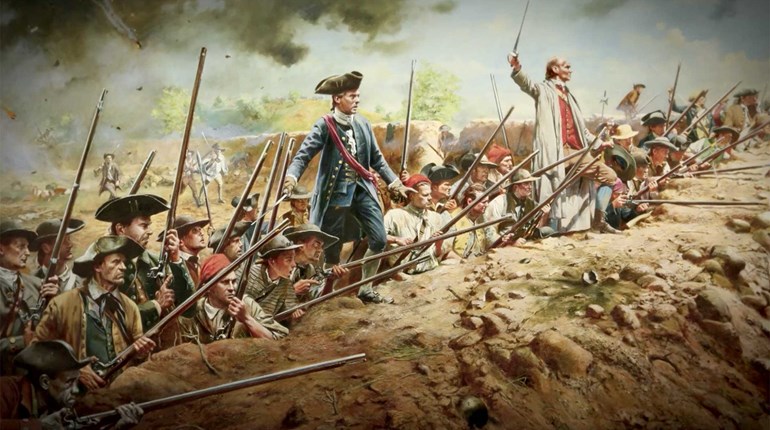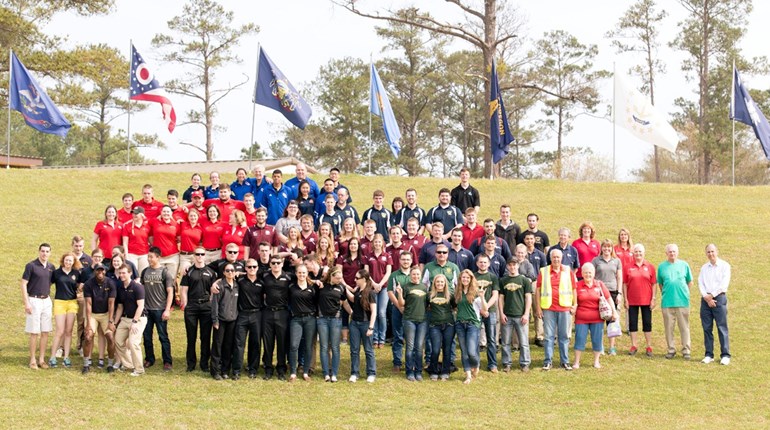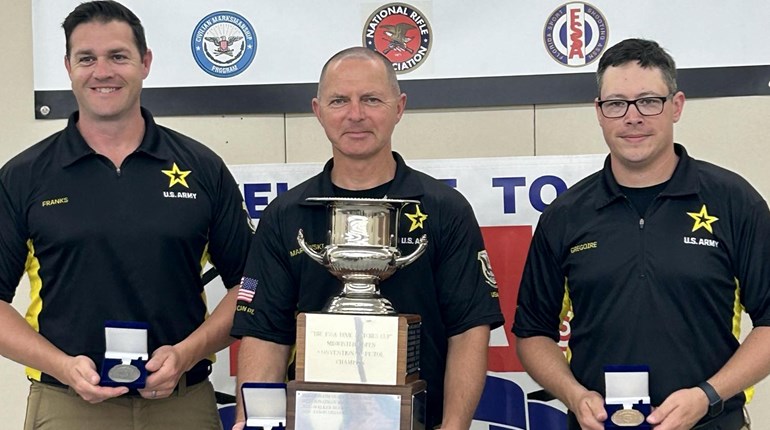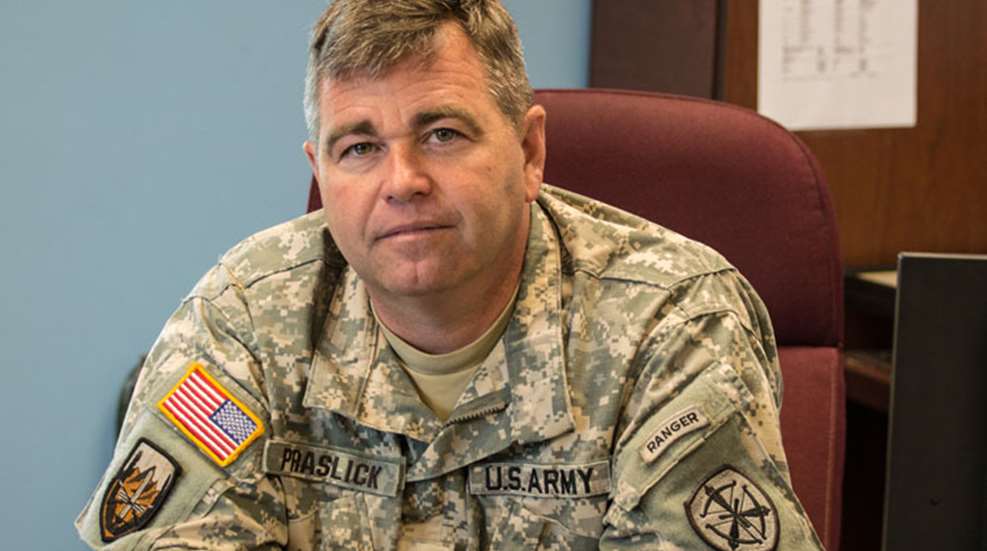
Praslick is a legend in the long-range competitive shooting community. The long-time service rifle coach for the U.S. Army Marksmanship Unit (AMU), Praslick’s tenure will be soon coming to an end, with his upcoming retirement. With Praslick as coach, the team has won an enormous amount of championships and records, throughout the country and the world. The AMU service rifle team is one of the world’s best and, during Praslick’s coaching tenure, has not deviated from that standard.
This past March, I traveled to Fort Benning, Georgia, home of the AMU—to see the legend face-to-face. I learned that SFC Praslick is much more than a coach, he’s a standard of excellence that has come to define the AMU service rifle team in recent memory.
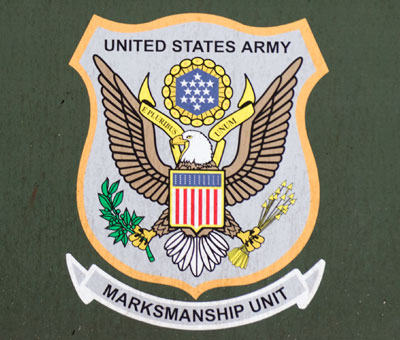 I met SFC Praslick during the NRA Intercollegiate Championships. Careful planning with the AMU allowed me to catch Praslick in his office, when he had rare free time. My AMU contact, SFC Piper (who handles press for the AMU) escorted me there, where I finally met the man from his famous Reading the Wind videos online. Praslick greeted me with a smile. He has the commanding presence I expect from a coach in any sport. He reminded me of the iconic boat captain Quint, from the movie Jaws. It was apparent that I was in the presence of a man who does not need his time wasted by my questions. SFC Praslick’s reputation precedes him … I needed to be careful with my questions, or I could be on the receiving end of a severe browbeating.
I met SFC Praslick during the NRA Intercollegiate Championships. Careful planning with the AMU allowed me to catch Praslick in his office, when he had rare free time. My AMU contact, SFC Piper (who handles press for the AMU) escorted me there, where I finally met the man from his famous Reading the Wind videos online. Praslick greeted me with a smile. He has the commanding presence I expect from a coach in any sport. He reminded me of the iconic boat captain Quint, from the movie Jaws. It was apparent that I was in the presence of a man who does not need his time wasted by my questions. SFC Praslick’s reputation precedes him … I needed to be careful with my questions, or I could be on the receiving end of a severe browbeating.SFC Praslick is a to-the-point kind of guy. After inviting me to sit, he asked “[So] what do you want to know?” My reply was equally succinct: “Whatever Google won’t find for me, let’s start with that.” What followed was an inspiring conversation with a truly remarkable man.
PRASLICK ON PRASLICK
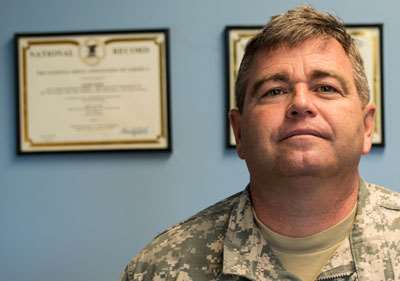
He eventually found his way out of the Army and attended college. After college, Praslick joined the National Guard and continued competition shooting. He rejoined the AMU as a shooter until 2004 when he was first tapped as Service Rifle Coach for the team.
When I asked him what’s the best shooting advice he’s ever received, he answered "Grant Singley once said, ‘don't pull the trigger unless it's in the middle.’”
ON COACHING
Praslick’s abrasiveness on the firing line is legendary. But necessary? No doubt about it. How else can one of the world’s best shooting teams be motivated?
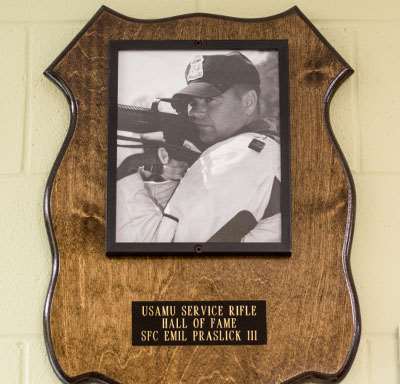
“I have a saying, ‘it’s easy to drive a Cadillac.’ I don’t have to do much when I am coaching these guys.” He continued “… [A] good shooter knows the difference between strategy and tactics.” Later on, when I asked him about his hobbies, he mentioned chess, leading us back to the topic of astute planning.
“Chess and shooting are very similar, in that both require a knowledge of strategy and tactics” he said. I asked him to elaborate. "An example of acting tactically is shooting into the wind, adjusting your aim, and assessing. Drafting a plan for execution is strategy. A good shooter knows the difference.”
When asked about coaching in general, Praslick’s eyes widened, as if he was a professor about to converse with a star pupil. The same man I had seen from Reading the Wind appeared. He had been feverishly looking up shooting titles and records on his iPad, but he then put it down and gave me 30 years of coaching advice in 30 minutes. I was all ears.
“[When] I began coaching for the AMU in 2004, I encountered some difficulty at first. I had to find a way to get the team to have confidence in me. It is impossible to coach someone that does not believe in you. If a shooter doesn’t trust you that is a problem.”
Praslick did end up gaining his team’s confidence. But, that does not mean he was not willing to take risks, or rather allow his shooters’ some leeway in how they do their jobs. He recalled an interesting anecdote. “I was coaching the team [at a four-man match] in West Virginia. Our four-man team was on pace to break a long-standing 600-yard high power record. The conditions were terrible, extremely windy.”
Windy conditions during long-range matches are Praslick’s specialty. He continued: “[Two] team members asked me if they could call the wind on their own. I was faced with a difficult decision: allow my team to make a choice that will definitely cost us the record, or deny them the trust I had so carefully cultivated over the years. I ended up letting them call the wind [for their pair], while calling the first pair myself.”
“What happened?” I asked. I was on the edge of my seat. Praslick is a compelling story-teller.
“They called it wrong” he said. “[It] cost us the record.” The AMU service rifle team gained complete confidence in Praslick during that windy team match in West Virginia. Any doubt in his coaching ability ceased to exist. I had to know more, so I prodded him—“Why did you let them call their own wind?”
“Coaching this team is as much about keeping them mentally prepared, as it is having them practice their shooting. Managing personalities, keeping them in one everlasting mindset: when the AMU goes to the firing line, they are supposed to win. Period.”
If you spend enough time with the teams, it quickly becomes known that the AMU’s major focus is on the win mission. Praslick never mentioned this once to me. He didn’t have to, because Praslick personifies the statement. His entire job is one big win mission. This became clear to me, when I asked him whether coaching is something you are born with, or something you learn. He replied with three qualities a competitive shooting coach must have.
“You have to be analytical. You must have empathy, so you know what they are going through. But most of all, you have to be a good shooter.”
I next asked Praslick what he considers to be bad coaching. “There is pressure for any coach to make the correct call. I’ve seen where coaches do not adapt to changing conditions, instead insisting on set procedures and set disciplines. That is bad coaching."
Praslick uses an effective mix of old and new, in coaching the service rifle team. “I often look back to training manuals from the 1920s. The fundamentals of marksmanship have not changed since then.” He is also well-versed on the latest advances in tech, especially wind data. “Equipment and technology have advanced long-range competition. In order to dominate, you must adapt to change.”
The contrast between old-school and modern marksmanship is visible in Praslick’s office; or at the team’s range. Both are a delightful mix of distinguished shooting memorabilia, as well as high technology. “Our 600-yard range is equipped with an electronic target system, one of the best in the world. We haven't looked back since,” Praslick told me, beaming with pride.
I was surprised to learn that Praslick actually spends the majority of his time training other troops. “The competition aspect is only fifty percent of my job. The other half is developing training plans, managing the team and balancing it all.” He made it sound humdrum. “The toughest part of my job is balancing the training and management aspects.”
The training provided by the AMU to the Army is a critical part of their mission, and SFC Praslick managed to balance this aspect with the other, winning championships.
END OF AN ERA
SFC Praslick will retire from the AMU later this year. SFC Shane Barnhart will be the new coach of the AMU service rifle team. I asked Praslick how he was preparing the next service rifle coach, since he has pretty big shoes to fill. Praslick has the utmost confidence in his successor. He replied, with zero hesitation: “Shane has been there, done that. There is no doubt in my mind he will excel.”
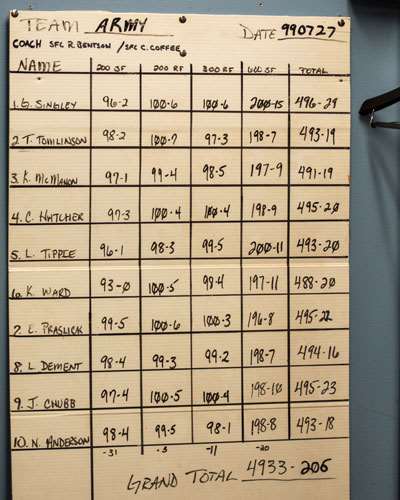
At the end of our allotted time, I had to ask him a question that had been lingering in my mind during our conversation. “Do you have any regrets?” I asked, being non-specific. Praslick didn’t flinch in his response. “No regrets. I earned my reputation, because I was busy doing my job. Coaching the service rifle team.” It echoed what he had told me earlier, “… my job is to maximize the overall team score.”
On my last day at Fort Benning, I ran into my former coworker Janet Raab, currently the director of marketing and sales for Walther. As former NRA high power rifle match director at Camp Perry, Jan brings a unique perspective. She had this to say about SFC Praslick:
“Emil had developed a reputation for tenaciousness at Camp Perry. He had good ideas about improving the nationals, not all of which we could implement. I could tell he cared deeply about the sport, and that is what made him a great coach. He cares about his team, and wants them to win.”
I would like to thank the U.S. Army Marksmanship Unit, SFC Emil Praslick III, and SFC Raymond Piper of the AMU’s Public Affairs Office—all were instrumental in the making of this story.













